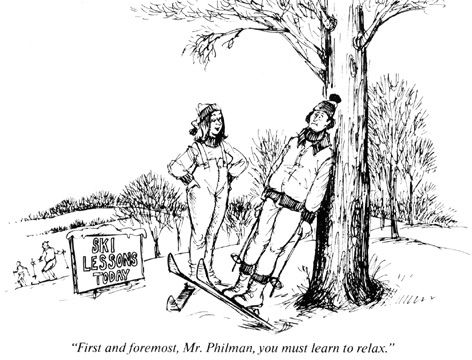The 1980s: Get Yours and Let the Good Times Roll
Authored by Morten Lund
Things cooled down considerably in the 1980s. In the end, ideology evaporated. Skiing Right, out in 1983, became a requiem rather than a victory song for the inner approach to ski instruction. The considerable loosening of moralistic ethics remained intact but otherwise the New Age influence in skiing went under. Beginning in the 1980s, skiing stuck to investing intensively in its infrastructure, keeping an eye on the bottom line exclusively.
If anything, the 1980s signalled the return of irony. In cartooning there was Warren Miller’s In Search of Skiing. Warren was always ironic, now he was more so, going after sacrosanct subjects such as speed skiing (“…200 pounds of Swiss potatoes in an Italian stretch suit”). A sharp and ironic fellow, Jerry Emerson, came out with The Crazy World of Skiing in 1981, and Bob Cram rose to a fine peak of irony in the 1983 The Real Skiers’ Dictionary—Cram at his most brilliant.
And sport itself turned somewhat ironic. Freestyle went professional in the 1980s as a sign of the decade, but it self-destructed in the 1980s, too, going down in such an excess of greed that the freestyle circuit sponsors finally backed off.
The sport’s emphasis on the bottom line, ironically, caused a business backlash. The consequent loss of small “feeder” ski areas proved to be a considerable problem. For the first time, the sport faced declining numbers of skiers. In the 1980s, millions of dollars were poured into resort after resort to improve lifts, improve grooming, provide near-100% coverage in snowmaking, build vastly-improved hotels, renovate the old inns, inspire good restaurants and build the condominiums for which there was strong demand. Resort-making had always been a capital-intensive enterprise. Now investment was life-or-death. For the small ski areas, this proved fatal. They could not compete. With the demise of several hundred mom-and-pop ski areas came a rapid fall-off of new skiers. The sport began to gray. Had it not been for the rise of snowboarding using the same facilities, ski resorts would have faced a strong contraction rather than merely stagnant numbers.
Snowboarding came out of nowhere in the 1980s, a sideshow that grew exponentially and thrust itself into the main tent. The ski cartoonists were longtime diehard skiers so the new intruder got little attention from them. But boarding created its own cartoonists and its own cartoon books outside the stream of ski history.
Skiers did decline in number but, as a whole, spent more, enabling the resorts to keep investing in themselves. The level of skiing improved as the equipment, snow conditions and lift facilities improved. Two of Cram’s cartoons in The Real Skiers’ Dictionary made fun of the fear inspired by the steeps but reflect the truth that a larger percentage of skiers were trying stiff inclines. There were many more skiers on expert terrain than ever before, particularly since most steeps were being cleared of moguls, thanks to the new technique of lowering grooming machines down from the top of the steepest runs tethered to a cable in turn fastened to a grooming machine on top.
Heliskiing, the province of the very top echelon skiers (either in income or technique or both), became nearly a mass sport. This had to do with the invention of the wide powder ski, beginning with the Miller Soft in 1972. Earl Miller’s design brought powder skiing within the reach of the intermediate. The descendants of the Miller Soft were everywhere in the 1980s. The accelerating affluence made price (powder skiing is pricey) no object. Canadian Mountain Holidays gave out more and more of their special powder suits to clients who had skied a million vertical feet. The ultimate was becoming the right stuff. Extreme skiing ballooned into international competition, speed skiing prospered, both were endeavors as safely elite as skiing steep terrain and deep powder had once been.
There was, of course, a backlash to the vast improvements and complete makeover of the resorts. It appeared as a wave of nostalgia for the smaller, simpler, not to say less expensive, world. Nostalgia for the rougher, less polished time. Nostalgie de la boue, “the fond remembrance of the mud,” as the French have it. There were anniversaries to be celebrated. Sun Valley celebrated its fiftieth, and Ski celebrated its fiftieth. Aspen celebrated its fortieth. Skiing was now a mature sport and therein lay its glories and its problems.
The 1985 The Summits of Samivel turned out to be an exercise in nostalgia. Samivel gloried in the bad old days when breakable crust lay like granite slabs, when the good way to slow down was to stick the poles between the legs and pull up on them, when skiing was subject to the limitation of the long-lost kick turn—there was no going up the mountain until it was learned. Ah, the old days. -- Morten Lund
